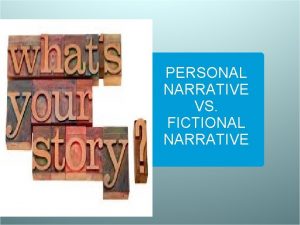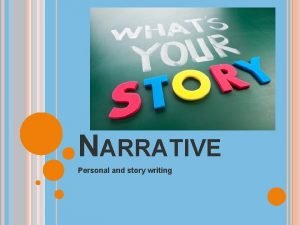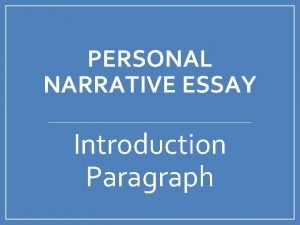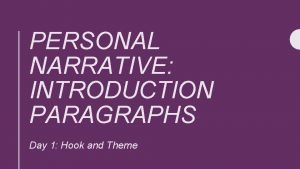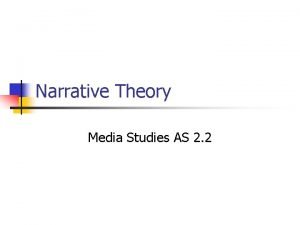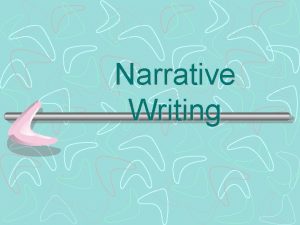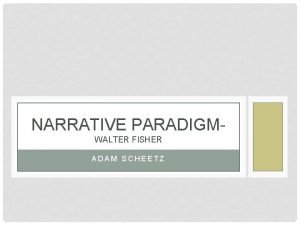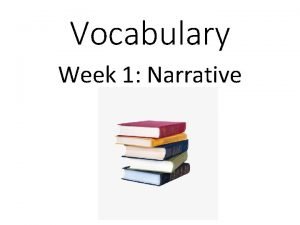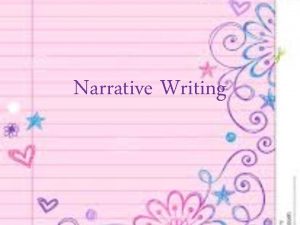Introduction to narrative theory What is narrative In








- Slides: 8

Introduction to narrative theory

What is narrative • In media terms, narrative is the coherence/organisation given to a series of facts. The human mind needs narrative to make sense of things. We connect events and make interpretations based on those connections. In everything we seek a beginning, a middle and an end. We understand construct meaning using our experience of reality and of previous texts. • Narrative is important as every culture has defining stories, stories about who we are, what we believe, where we came from, how we got here, etc. These stories are extremely important to group identity and cultural transmission (values, goals, customs, beliefs, mores, etc. ). But narrative doesn’t just matter for large groups of people; it is extremely important for smaller groups of people too, like families, as well as at the individual level. • Terry Pratchett famously said “People think that stories are shaped by people. In fact, it’s the other way around”, this is extremely poignant in understanding why narrative is so important. It shapes our lives

Propp • • • Vladimir Yakovlevich Propp (29 April 1895 – 22 August 1970) was a Soviet folklorist and scholar who analysed the basic plot components of Russian folk tales to identify their simplest irreducible narrative elements. After studying 100 fairy-tales, Vladimir Propp developed a character theory for studying media texts and productions. Prop discovered that all characters fall into 7 broad character types, all of which can be found in a variety of different media: Hero: Reacts to the donor and saves the princess, often resulting in them falling in love with the princess. The villain: Locked in a constant struggle with the hero, often trying to harm princess. The donor: Gives the hero an object or a piece of information that helps them prepare for what is to come. The helper: Assists the hero with their quest, often referred to as their 'sidekick'. The princess: Needs assistance from the hero, usually because they are in some form of danger, typically the princess is the victim within the narrative. The dispatcher: Is the character who sends that hero on their mission or quest. False hero: May appear good but has an ulterior motive, or attempts to take credit for the hero's actions.

Applied Propp – Batman The Dark Knight • The Hero = Batman – As a “superhero” Batman is the traditional hero. He aims to save everyone, however, in some ways he in untraditional. He is unorthodox in the way he deals with things as he has a dark past and often resorts to violence. • The Villain = The Joker – He is the obvious villain, a sadistic trouble maker who aims to destroy the society he lives in, as well as Batman. • The Donor = Lucius Fox – As Batman’s quartermaster he gives the Hero all of the tools he needs to resolve the conflict. • The Helper = Commissioner Gordon – Gordon can be seen as the sidekick as he aids the hero like a sidekick. • The Princess = Rachel – As Batman’s ex-girlfriend Rachel is an untraditional Princess, however, her need to be saved. • The Dispatcher = Batman – Doubling up as both the hero and the dispatcher as he sends himself on his own missions. • False Hero = Harvey Dent – Dent appears to be a hero but later turns out to be Two-Face, who is the obvious false hero.

Barthes • Barthes was a French theorist who believed there were 5 codes that were behind a story. These are: • Hermeneutic/Enigma – This is the mystery in a text • Proairetic/ Action – This is the suspense building elements • Semantic – These refer to additional meanings • Symbolic – This is about symbolism within the text • Referential – This is anything in the text that refers to external knowledge. • Barthes' ideas explored a diverse range of fields and he influenced the development of schools of theory including structuralism, semiotics, social theory, design theory, anthropology and post-structuralism.

Todorov • In 1969 Todorov stated there were 5 stages that in all films there are five stages the narrative can progress through: • 1. A state of equilibrium (All is as it should be. ) • 2. A disruption of that order by an event. • 3. A recognition that the disorder has occurred. • 4. An attempt to repair the damage of the disruption. • 5. A return or restoration of a new equilibrium • Todorov's greatest contribution to literary theory is thought to be his defining of the Fantastic, the fantastic uncanny, and the fantastic marvellous. Todorov defines the fantastic as being any event that happens in our world that seems to be supernatural. Upon the occurrence of the event, we must decide if the event was an illusion or whether it is real and has actually taken place.

Todorov applied - Taken • 1. Brian and his daughter see each other regularly, fairly normal suburban life • 2. Brian’s daughter is kidnapped while backpacking. • 3. Brian does the famous phone call before setting off to find her. • 4. Brian shoots his way through the sex traffickers until he eventually finds his daughter. • 5. They arrive home safe.

Levi-Strauss • Levi – Strauss suggested that all narratives could be reduced down to binary opposites, this is the foundation of all narratives. • For example: Good vs. Evil, Light vs. Dark, Love vs. Hate, Sanity vs. Insanity, Strong vs. Weak. • In Levi-Strauss's view, it is by these opposing binary concepts that humans make sense of the world. • The use of opposites in modern media allow us to establish opinions very quickly. In Batman: The Dark Knight right from the start we see the serious, regimented Batman solving crime. Juxtaposed to this is the Joker; a colourful, loud character who kills right from the start. • Many people recognise Levi–Strauss’s great pessimism as not only an anthropologist but also a person. In one of Levi-Strauss's last interviews, he says: "It's clear that the density of human beings is so great, they have begun to poison themselves. And the world on which I am finishing my existence is no longer a world I like. "
